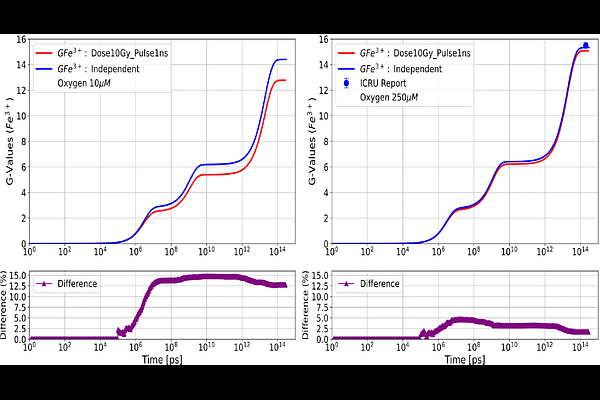Monte Carlo track-structure simulation of the impact of Ultra-Hight Dose Rate and oxygen concentration on the Fenton reaction.

Monte Carlo track-structure simulation of the impact of Ultra-Hight Dose Rate and oxygen concentration on the Fenton reaction.
Chaoui, M.; Tayalati, Y.; Bouhali, O.; ramos mendez, j.
AbstractBackground: Preclinical investigations studies have shown that FLASH radiotherapy (FLASH-RT), delivering radiation in ultra-high dose rates (UHDR), preserves healthy tissue and reduces toxicity, all while maintaining an effective tumor response compared to conventional radiotherapy (CONV-RT), the combined biological benefit was termed as \'\'FLASH effect\'\'. However, the mechanisms responsible for this effect remain unclear. Research demonstrated that oxygen concentration contributes to the FLASH effect, and it has been hypothesized that Fenton reaction might play a role in the \'\'FLASH effect\'\'. Purpose: We propose to investigate the effect of ultra -high dose rate (UHDR), compared to conventional dose rates (CONV), on the Fenton reaction by studying the radiolysis of Fricke solution. The study will focus on how dose, dose rate, and initial oxygen concentration influence the activation of the Fenton reaction. Methods and Materials: TOPAS-nBio version 2.0 was used to simulate the radiolysis of the Fricke system. A cubic water phantom of 3m side was irradiated by 300MeV protons on one of its edges. For UHDR, a proton field (1.5 x 1.5 m2) was delivered in a single pulse of 1ns width. The protons were accumulated until reached 5Gy or 10Gy absorbed dose. For CONV, the independent history approach was used to mimic 60Co irradiation. For both dose-rates, oxygen concentrations representative of hypoxic and normoxic tissues (10 - 250 M) were simulated. The Gvalue for oxidant ions G(Fe3+) and {Delta}Gvalue of Fenton reaction (H2O2 + Fe2+ [->] Fe3+ + OH- +OH) were scored. The simulations ended after G(Fe3+) achieved steady state, and calculated yields were compared with published data. Results: For CONV, G(Fe3+) agreed with ICRU-report 34 data by (0.97 {+/-} 0.1) %. For UHDR, G(Fe3+) agreed with ICRU data by (1.24 {+/-} 0.1)% and (0.92 {+/-} 0.1)% for 5Gy and 10Gy, respectively. Notably, UHDR at 10 Gy reduced the occurrence of Fenton reactions by (1.0 {+/-} 0.1)% and (11.5 {+/-} 0.1)% at initial oxygen concentrations of 250 M and 10 M, respectively. In consequence, UHDR decreased G(Fe3+) by (1.8 {+/-} 0.1)% and (12.5 {+/-} 0.1)% at these oxygen levels. Additionally, increasing the absorbed dose to 15 Gy and 20 Gy at low oxygen (10 M), UHDR further reduced the {Delta}G-value by (15.7 {+/-} 0.1)% and (18.6 {+/-} 0.1)%, respectively. The decrease was driven by intertrack effects present in UHDR pulses and its impact on the scavenging effect that oxygen had over hydrogen radicals. Conclusions: UHDR reduces the yield of Fe3+ (G(Fe3+)) and significantly impacts Fenton reactions, particularly at low oxygen concentrations, while showing minimal effects at higher oxygen levels. This effect becomes more pronounced at higher dose thresholds, such as 10 - 20 Gy. This emphasizes the important role of the initial oxygen concentration in UHDR and its influence on the Fenton reaction, a mechanism that may contribute to elucidate the FLASH effect.